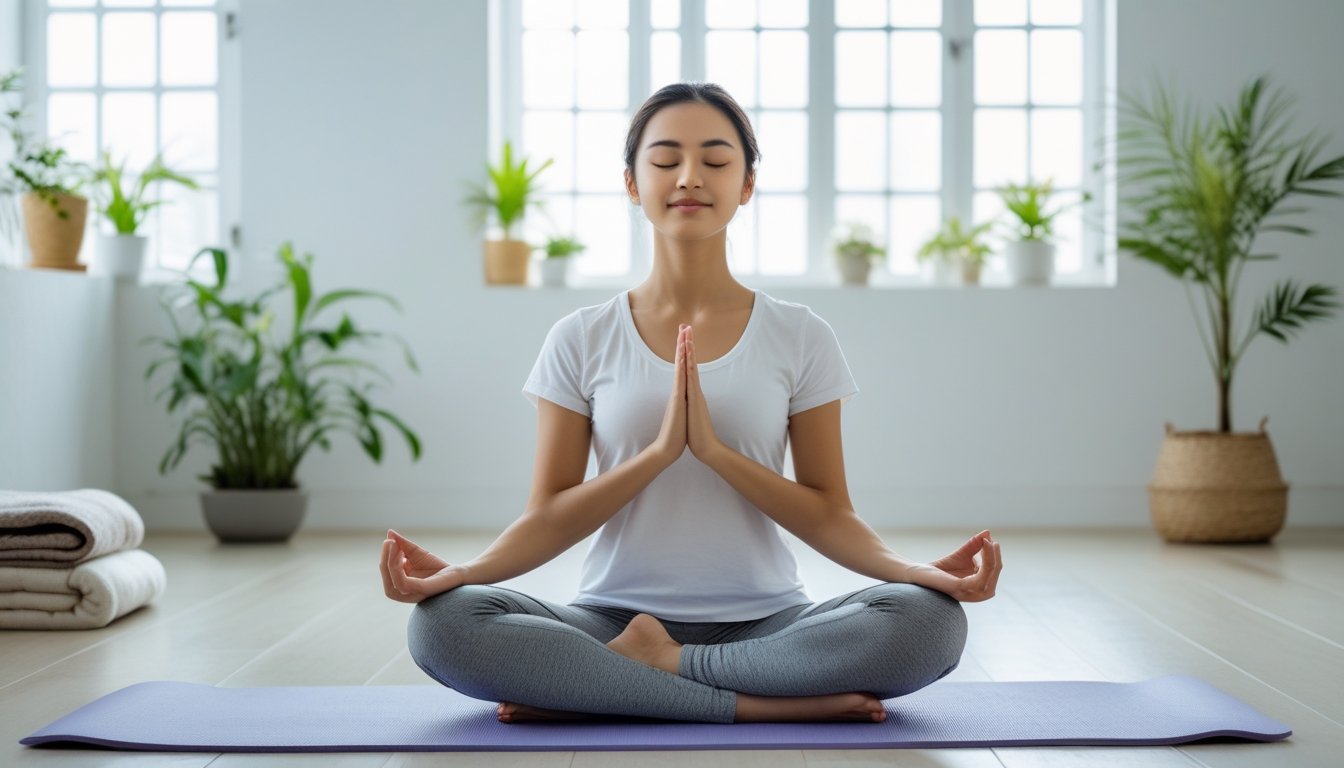Late updated: 05 Aug 2025 15:08
Written by: Ella Thompson
Addressing Anxiety Through Mindful Breathing Techniques: Effective Stress Management
Amidst the whirlwind of our fast-paced lives, anxiety has become a familiar companion for many. While there are numerous methods to help manage stress and enhance mental health, mindful breathing stands out as a practical and effective approach. Mindful breathing techniques have the power to calm our nervous system and decrease anxiety, offering us a simple tool to regain control in stressful situations.

As we explore these techniques, we unearth their transformative ability to help us anchor ourselves in the present. By focusing on our breath, we can create a sense of tranquillity amidst chaos and turmoil. This practice not only alleviates stress but also enriches our overall mental health.
From deep diaphragmatic breathing to box breathing, these methods are rooted in simplicity and accessibility. They require no special equipment or environment, making them adaptable to any setting where we find ourselves. Let us dive into the immediate benefits and long-term relief that mindful breathing offers in our journey towards anxiety management.
Key Takeaways
- Mindful breathing decreases anxiety by calming the nervous system.
- Techniques like deep breathing are simple and accessible anywhere.
- Breathing exercises enrich mental health by anchoring us in the present.
How Mindful Breathing Influences Anxiety and the Body
Mindful breathing offers significant benefits for anxiety management by modulating how the body and mind respond to stress. This practice brings awareness to the breath, helping to create a sense of calm and balance within our nervous system.
The Science Linking Breathing Patterns and Anxiety
Breathing is closely linked to how we experience anxiety. Research indicates that deliberate, slow breathing can reduce anxiety by altering oxygen and carbon dioxide levels in the blood. Decreased oxygen and increased carbon dioxide can trigger feelings of panic. By controlling our breath, we moderate this balance, reducing anxiety sensations. Patterns such as diaphragmatic breathing engage the diaphragm, promoting fuller oxygen exchange and fostering relaxation. When practised consistently, this breathing technique can lead to lasting anxiety reduction.
The Role of the Nervous System in Anxiety Response
Our autonomic nervous system consists of the sympathetic and parasympathetic branches. While the sympathetic nervous system is responsible for the fight-or-flight response, increasing heart rate and stress hormones like cortisol, the parasympathetic nervous system fosters relaxation and recovery. Mindful breathing activates the parasympathetic system, countering the effects of the sympathetic response. As a result, we experience reduced heart rates and a calmer mind. This illustrates how breathing strategies can manage negative emotions and improve mental health.
Physical Symptoms of Anxiety and Their Connection to Breath
Anxiety often manifests physically as increased heart rate, muscle tension, rapid breathing, and dizziness. These symptoms can create a feedback loop, escalating anxiety further. Through slow, controlled breathing, we can alleviate these symptoms. Diaphragmatic breathing slows heart rates and calms the nerves, essential for managing anxiety-induced physical reactions. By consciously regulating our breath, we gain control over symptoms, reducing their intensity and impact on our daily lives. This practice is instrumental in bridging the gap between mental and physical health.
Effective Mindful Breathing Techniques for Anxiety Relief

Mindful breathing is an impactful way to manage anxiety, helping to calm our nervous system and regulate emotional responses. We explore techniques such as diaphragmatic breathing, box breathing, and pranayama, each offering unique benefits. Pairing these with mindfulness and grounding can significantly enhance their effectiveness.
Diaphragmatic and Belly Breathing
Diaphragmatic breathing, often referred to as belly breathing, involves using the diaphragm efficiently rather than shallowly breathing through the chest. This method encourages deeper breaths, expanding the belly as we inhale and contracting it as we exhale. By focusing on the diaphragm, we foster calmer breathing that reduces stress and lowers blood pressure. The increased oxygen intake can help calm an overwhelmed system and is a straightforward technique to practice during stressful moments.
Engaging in belly breathing offers profound benefits. By placing one hand on the chest and the other on the abdomen, we can ensure that the abdomen rises more than the chest while inhaling. Regular practice can lead to improved anxiety management and emotional regulation. With its simplicity and effectiveness, diaphragmatic breathing remains a cornerstone of anxiety relief techniques.
Box Breathing and Square Breathing
Box breathing, also known as square breathing, is an easily remembered and practiced method. This technique involves four equal parts: inhale for a count of four, hold for four, exhale for four, and hold again for four. The symmetry in breathing helps us maintain focus, serving as a potent grounding technique during anxious times.
This method can enhance concentration and mental clarity, providing a sense of control over anxious thoughts. As we practice box breathing, our heart rate stabilises, and tension reduces, promoting a sense of calm. It's an effective choice for quick stress relief, lending itself well to various environments, from the office to moments of solitude, supporting our mental health consistently.
4-7-8 and Controlled Breathing Methods
The 4-7-8 breathing method is a structured approach that aids relaxation and emotional regulation. We inhale through the nose for four counts, hold the breath for seven, and gently exhale for eight. This sequence helps slow down the heart rate and promotes a state of tranquility, making it especially beneficial before sleep or in moments of panic.
Controlled breathing of this nature provides immediate anxiety relief. By focusing on specific counts, we distract ourselves from stressors, redirecting thoughts toward the rhythmic in-and-out flow of the breath. This technique can be modified by adjusting counts to personal comfort, offering flexibility while still delivering effective outcomes for calming the mind.
Pranayama and Alternate Nostril Breathing Techniques
Pranayama, an ancient practice rooted in yoga, involves various techniques like alternate nostril breathing (Nadi Shodhana). This practice balances the right and left sides of the brain, pairing breath control with mindfulness. By alternating nostrils, we enhance lung function and reduce anxiety.
Alternate nostril breathing promotes a calm state, helping rebalance mental energy. By breathing through one nostril while closing the other, we can activate and calm different parts of the nervous system. This technique is excellent for emotional regulation and can be practised at any time to maintain equilibrium.
Integrating Mindfulness and Grounding into Breathwork
Combining mindfulness with breathwork can amplify the effects of these techniques. Mindful breathing requires focused attention on the present moment and the sensation of each breath. Grounding exercises—like focusing on the sensations of the body in contact with surfaces—can complement breathwork, rooting us firmly in the present and away from anxiety.
Our practice can benefit from regular integration of these techniques into daily routines. By focusing both on breath and physical sensations, we cultivate greater resilience against anxiety. This holistic approach encourages relaxation and a deeper connection between the mind and body, fostering sustained mental well-being.
Frequently Asked Questions

In this section, we explore different mindful breathing techniques aimed at managing anxiety, discussing their effectiveness and applications. We cover methods like 4-7-8 breathing and examine the subtle nuances between various techniques.
What are the most effective breathing techniques for managing anxiety?
Several techniques stand out for their effectiveness. Diaphragmatic breathing involves engaging the diaphragm for deeper breaths. Box breathing requires inhaling, pausing, exhaling, and repeating. These methods promote relaxation by calming the nervous system.
Can breath control have an immediate effect on anxiety attacks, and how?
Breath control can indeed provide quick relief during anxiety attacks. Techniques like slow, controlled breathing help regulate the nervous system, reduce heart rate, and create a sense of calm. This immediate effect aids in diminishing acute anxiety symptoms.
Is the 4-7-8 breathing method beneficial for easing anxiety, and how should it be practised?
The 4-7-8 method is beneficial for easing anxiety, involving inhaling for 4 seconds, holding the breath for 7 seconds, and exhaling for 8 seconds. This technique slows the heart rate and supports relaxation, making it a practical choice for alleviating stress.
How does deep breathing occasionally exacerbate feelings of anxiety?
Though usually beneficial, deep breathing can sometimes heighten anxiety. Over-breathing or hyperventilation may occur, causing dizziness or light-headedness. It's important to practice mindful breathing gently without forcing depth or pace.
Are there specific breathing exercises recommended to alleviate stress?
Exercises like diaphragmatic breathing and progressive relaxation are often recommended. They focus on slow, intentional breaths and gradual muscle relaxation, reducing tension and stress. Incorporating these into daily routines can enhance overall mental well-being.
What are the differences between various breathing exercises documented for anxiety relief?
Different breathing exercises vary in technique and focus. Diaphragmatic breathing emphasises abdominal movement, while box breathing incorporates fixed timing patterns. Guided breath awareness engages mental focus. Each serves unique purposes and can be chosen based on personal preference and comfort.
